Environmental and Global Health Concerns: Australia Report
VerifiedAdded on 2022/10/15
|11
|2219
|19
Report
AI Summary
This report provides an executive summary of environmental and global health concerns, highlighting the increasing awareness of climate change and its impact on human health. It emphasizes the need to understand the connections between growth, climate, and health for sustainability. The report focuses on Australia, discussing the challenges posed by water scarcity due to diminishing environmental conditions, drought, and climate change, particularly in the Murray-Darling Basin. It discusses the factors contributing to water scarcity, including population growth, urbanization, and the impact of climate change on the water cycle. The report examines the Australian government's initiatives, such as environmental stream programs and water use limitations, to address these issues. It also highlights the importance of efficient water management, soil and water resource scheduling, and identifying water as a financial, cultural, and environmental benefit. The report concludes by emphasizing the need for strategic water management and the implementation of various solutions to support Australia's population growth and maintain environmental health.
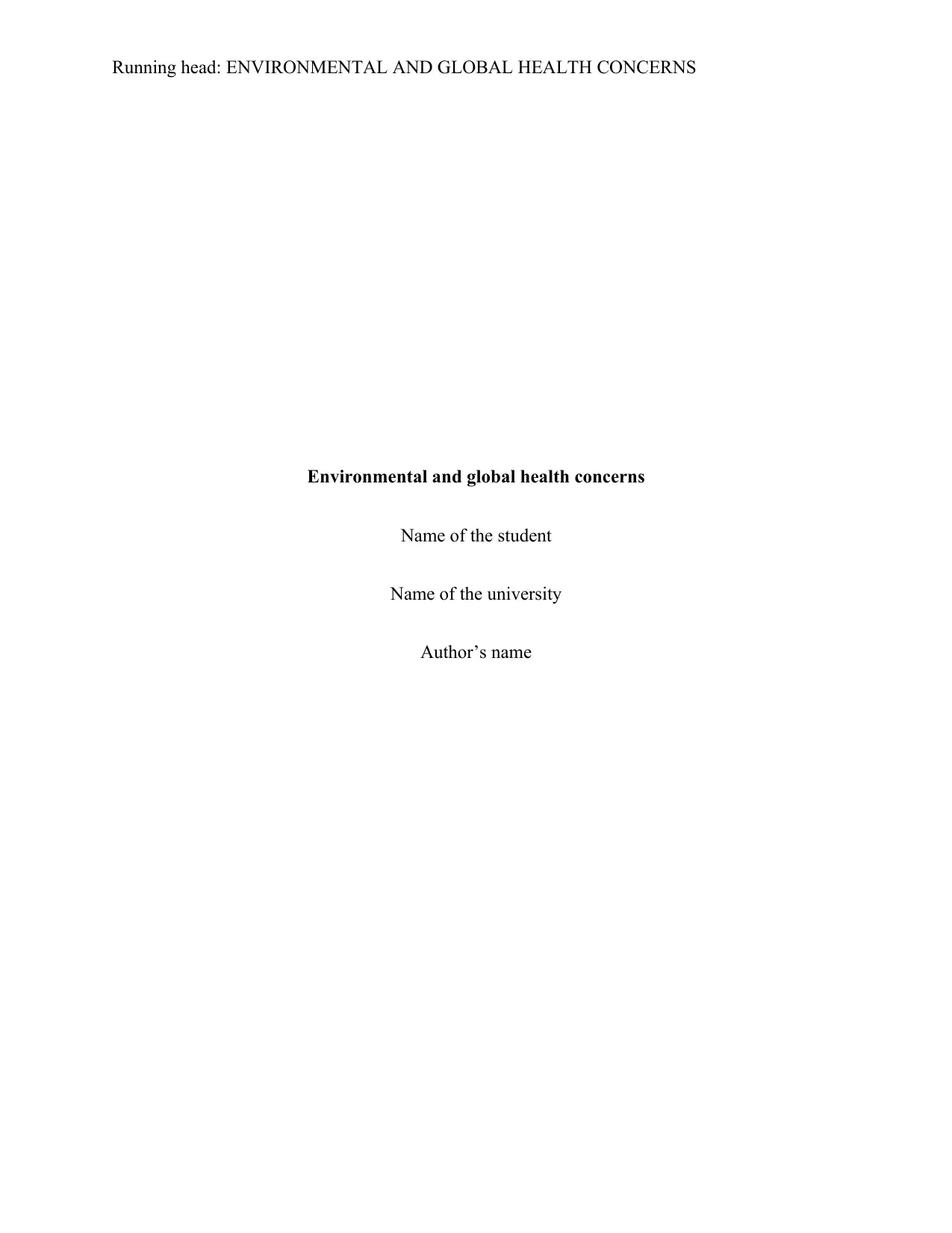
Running head: ENVIRONMENTAL AND GLOBAL HEALTH CONCERNS
Environmental and global health concerns
Name of the student
Name of the university
Author’s name
Environmental and global health concerns
Name of the student
Name of the university
Author’s name
Paraphrase This Document
Need a fresh take? Get an instant paraphrase of this document with our AI Paraphraser
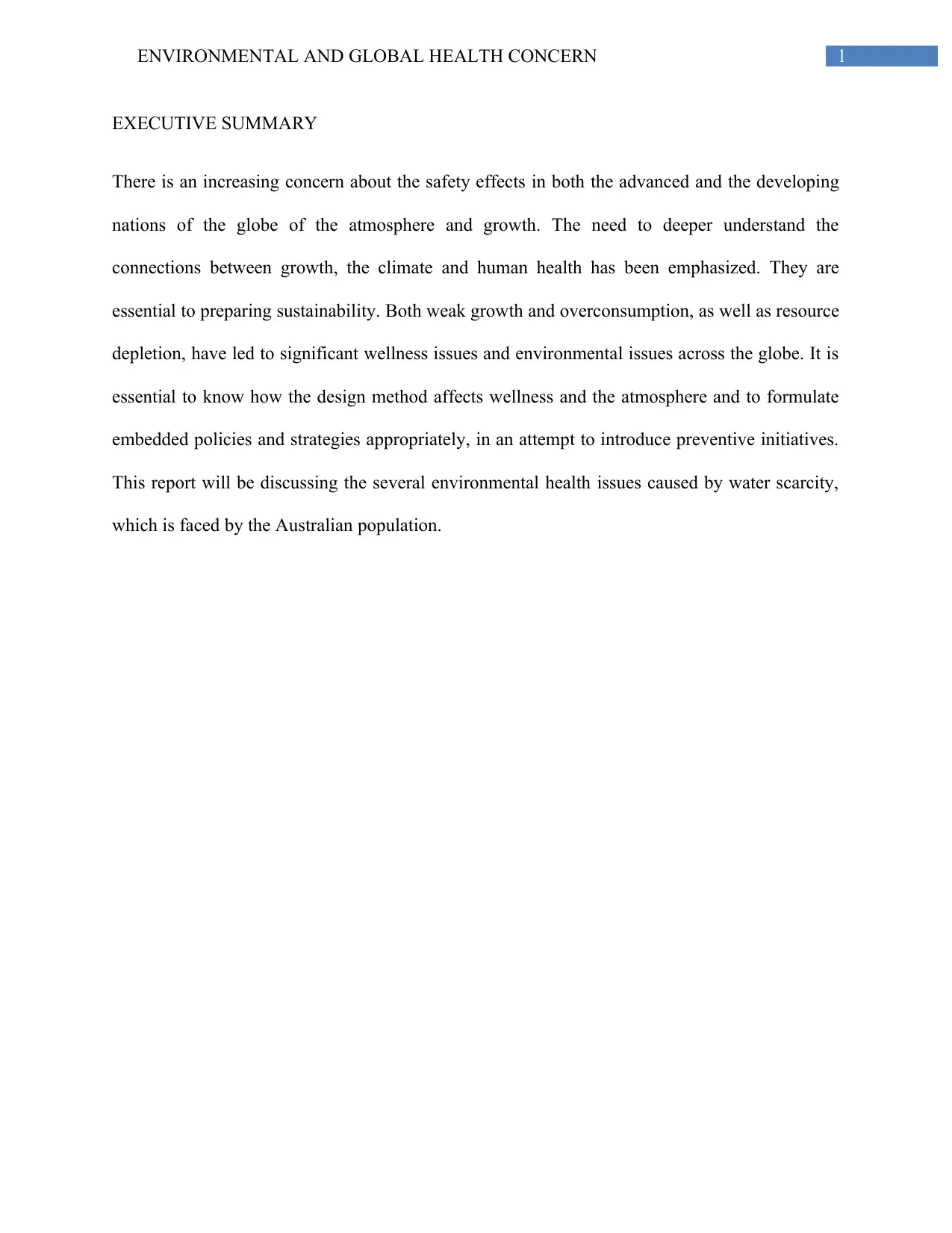
1ENVIRONMENTAL AND GLOBAL HEALTH CONCERN
EXECUTIVE SUMMARY
There is an increasing concern about the safety effects in both the advanced and the developing
nations of the globe of the atmosphere and growth. The need to deeper understand the
connections between growth, the climate and human health has been emphasized. They are
essential to preparing sustainability. Both weak growth and overconsumption, as well as resource
depletion, have led to significant wellness issues and environmental issues across the globe. It is
essential to know how the design method affects wellness and the atmosphere and to formulate
embedded policies and strategies appropriately, in an attempt to introduce preventive initiatives.
This report will be discussing the several environmental health issues caused by water scarcity,
which is faced by the Australian population.
EXECUTIVE SUMMARY
There is an increasing concern about the safety effects in both the advanced and the developing
nations of the globe of the atmosphere and growth. The need to deeper understand the
connections between growth, the climate and human health has been emphasized. They are
essential to preparing sustainability. Both weak growth and overconsumption, as well as resource
depletion, have led to significant wellness issues and environmental issues across the globe. It is
essential to know how the design method affects wellness and the atmosphere and to formulate
embedded policies and strategies appropriately, in an attempt to introduce preventive initiatives.
This report will be discussing the several environmental health issues caused by water scarcity,
which is faced by the Australian population.
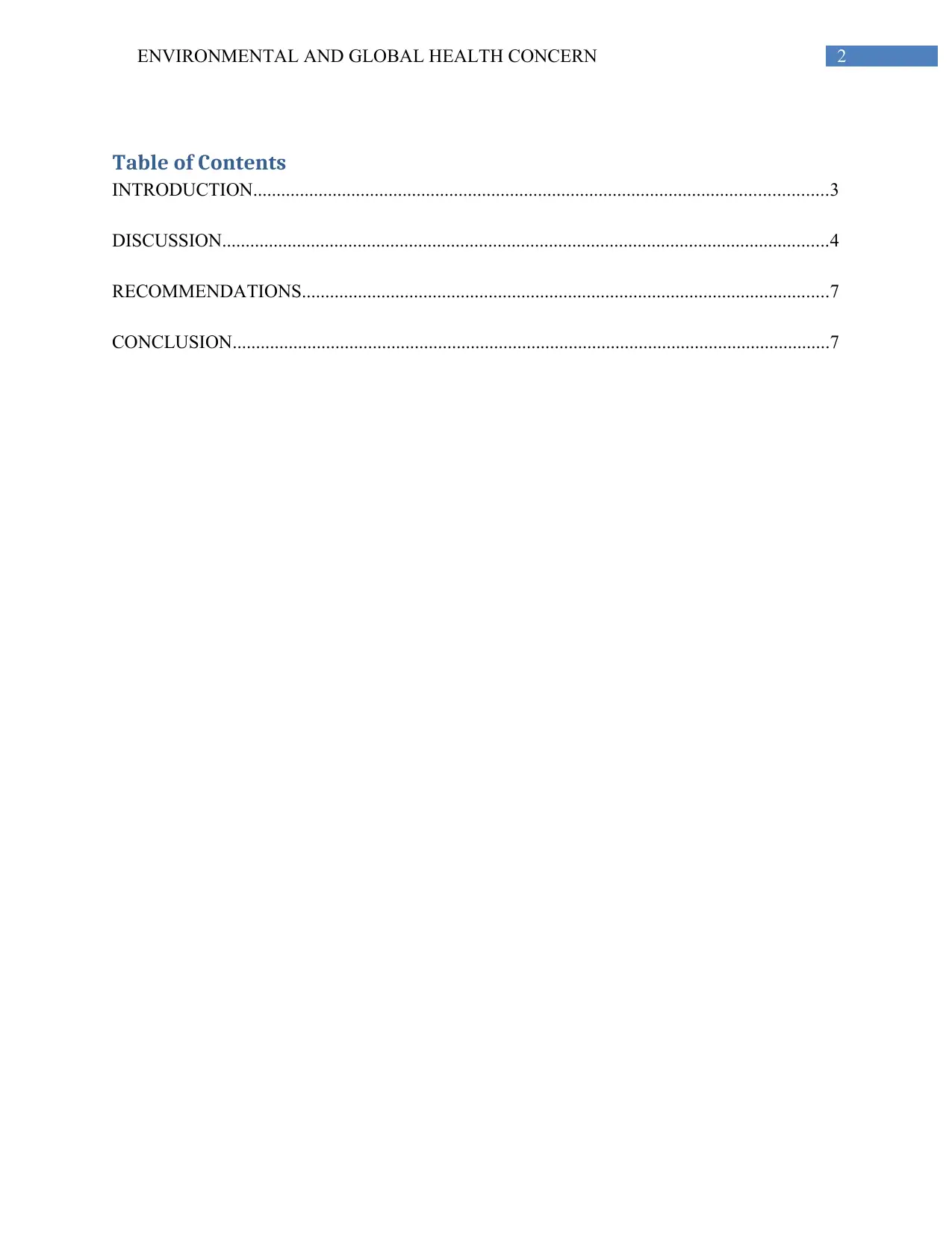
2ENVIRONMENTAL AND GLOBAL HEALTH CONCERN
Table of Contents
INTRODUCTION...........................................................................................................................3
DISCUSSION..................................................................................................................................4
RECOMMENDATIONS.................................................................................................................7
CONCLUSION................................................................................................................................7
Table of Contents
INTRODUCTION...........................................................................................................................3
DISCUSSION..................................................................................................................................4
RECOMMENDATIONS.................................................................................................................7
CONCLUSION................................................................................................................................7
⊘ This is a preview!⊘
Do you want full access?
Subscribe today to unlock all pages.

Trusted by 1+ million students worldwide
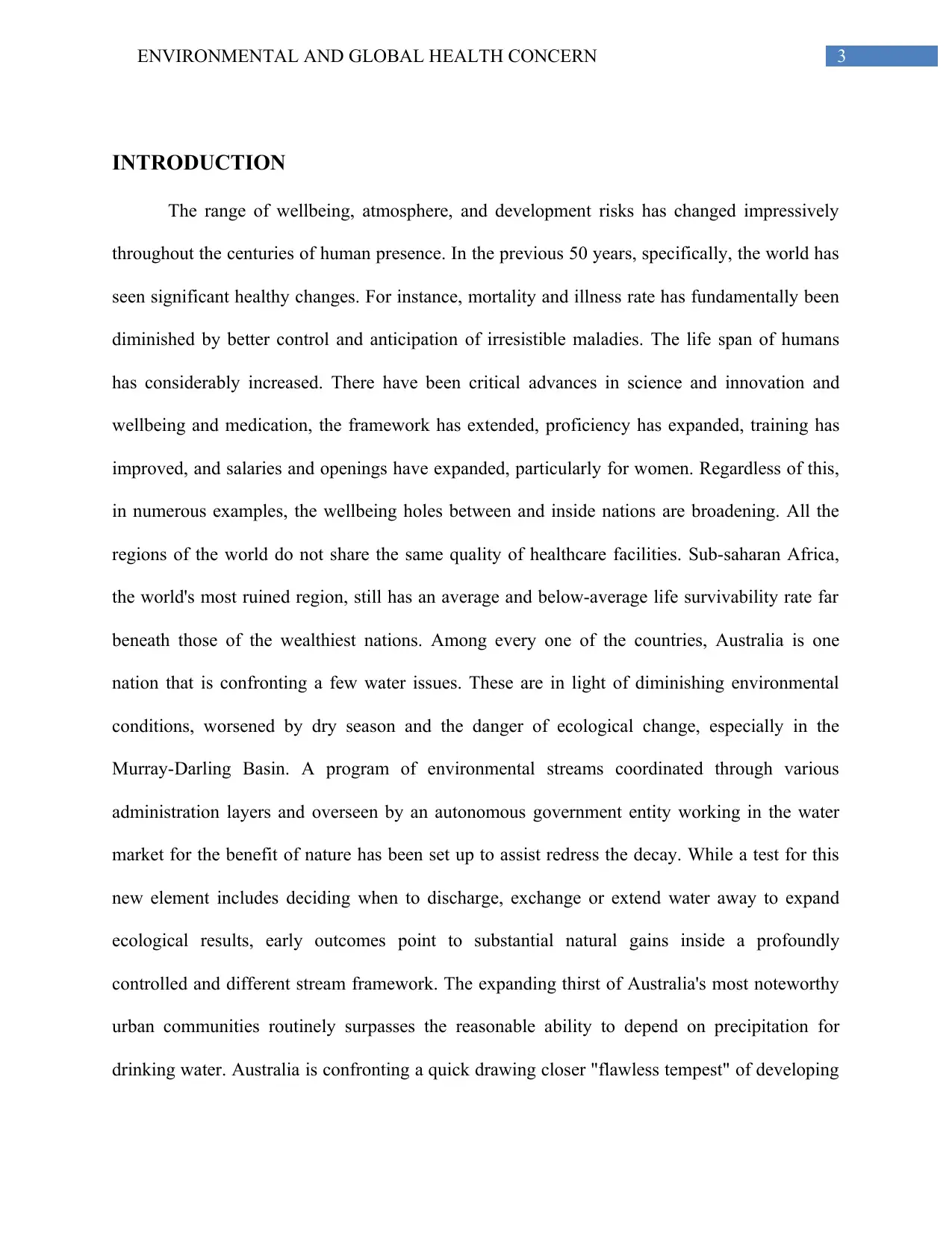
3ENVIRONMENTAL AND GLOBAL HEALTH CONCERN
INTRODUCTION
The range of wellbeing, atmosphere, and development risks has changed impressively
throughout the centuries of human presence. In the previous 50 years, specifically, the world has
seen significant healthy changes. For instance, mortality and illness rate has fundamentally been
diminished by better control and anticipation of irresistible maladies. The life span of humans
has considerably increased. There have been critical advances in science and innovation and
wellbeing and medication, the framework has extended, proficiency has expanded, training has
improved, and salaries and openings have expanded, particularly for women. Regardless of this,
in numerous examples, the wellbeing holes between and inside nations are broadening. All the
regions of the world do not share the same quality of healthcare facilities. Sub-saharan Africa,
the world's most ruined region, still has an average and below-average life survivability rate far
beneath those of the wealthiest nations. Among every one of the countries, Australia is one
nation that is confronting a few water issues. These are in light of diminishing environmental
conditions, worsened by dry season and the danger of ecological change, especially in the
Murray-Darling Basin. A program of environmental streams coordinated through various
administration layers and overseen by an autonomous government entity working in the water
market for the benefit of nature has been set up to assist redress the decay. While a test for this
new element includes deciding when to discharge, exchange or extend water away to expand
ecological results, early outcomes point to substantial natural gains inside a profoundly
controlled and different stream framework. The expanding thirst of Australia's most noteworthy
urban communities routinely surpasses the reasonable ability to depend on precipitation for
drinking water. Australia is confronting a quick drawing closer "flawless tempest" of developing
INTRODUCTION
The range of wellbeing, atmosphere, and development risks has changed impressively
throughout the centuries of human presence. In the previous 50 years, specifically, the world has
seen significant healthy changes. For instance, mortality and illness rate has fundamentally been
diminished by better control and anticipation of irresistible maladies. The life span of humans
has considerably increased. There have been critical advances in science and innovation and
wellbeing and medication, the framework has extended, proficiency has expanded, training has
improved, and salaries and openings have expanded, particularly for women. Regardless of this,
in numerous examples, the wellbeing holes between and inside nations are broadening. All the
regions of the world do not share the same quality of healthcare facilities. Sub-saharan Africa,
the world's most ruined region, still has an average and below-average life survivability rate far
beneath those of the wealthiest nations. Among every one of the countries, Australia is one
nation that is confronting a few water issues. These are in light of diminishing environmental
conditions, worsened by dry season and the danger of ecological change, especially in the
Murray-Darling Basin. A program of environmental streams coordinated through various
administration layers and overseen by an autonomous government entity working in the water
market for the benefit of nature has been set up to assist redress the decay. While a test for this
new element includes deciding when to discharge, exchange or extend water away to expand
ecological results, early outcomes point to substantial natural gains inside a profoundly
controlled and different stream framework. The expanding thirst of Australia's most noteworthy
urban communities routinely surpasses the reasonable ability to depend on precipitation for
drinking water. Australia is confronting a quick drawing closer "flawless tempest" of developing
Paraphrase This Document
Need a fresh take? Get an instant paraphrase of this document with our AI Paraphraser
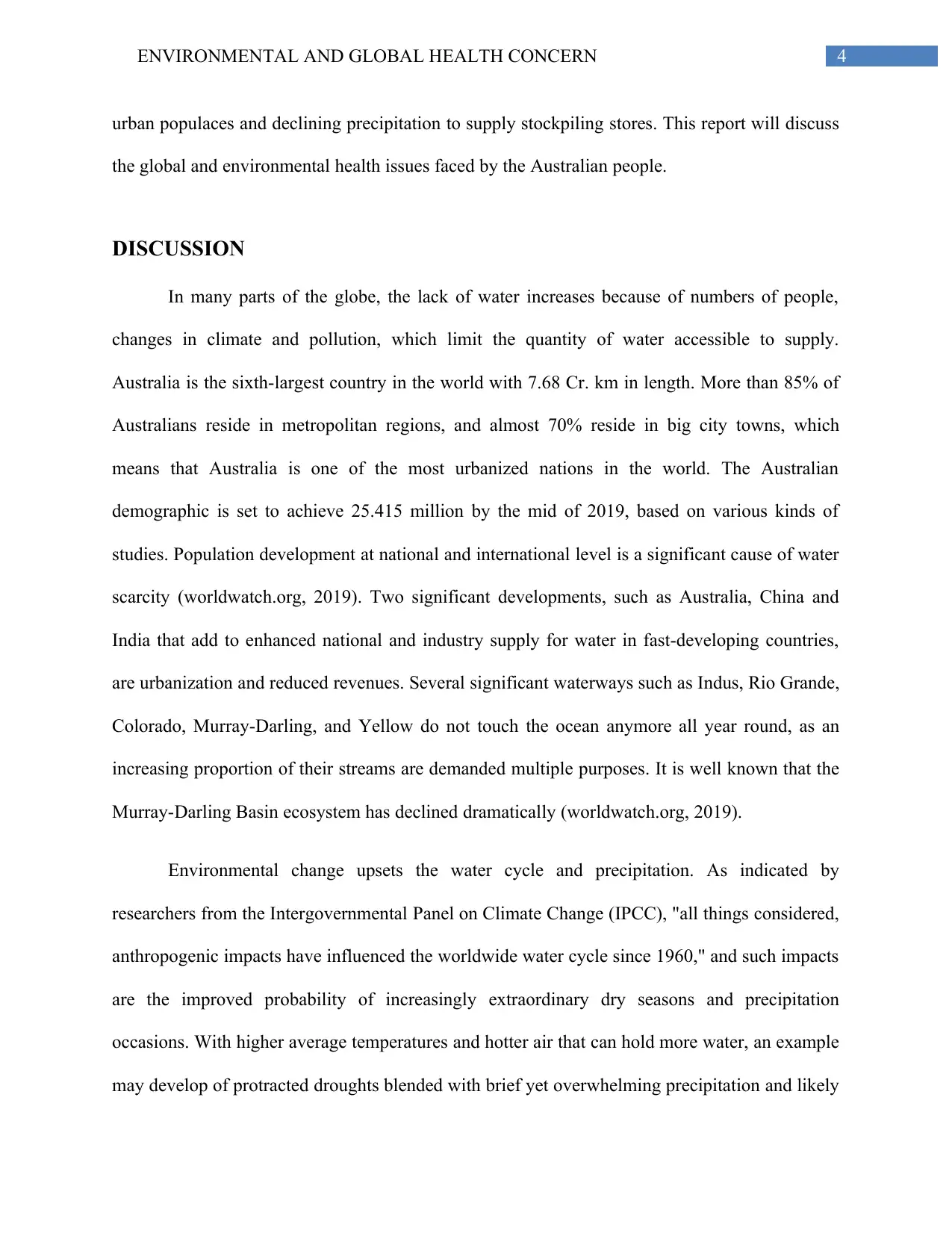
4ENVIRONMENTAL AND GLOBAL HEALTH CONCERN
urban populaces and declining precipitation to supply stockpiling stores. This report will discuss
the global and environmental health issues faced by the Australian people.
DISCUSSION
In many parts of the globe, the lack of water increases because of numbers of people,
changes in climate and pollution, which limit the quantity of water accessible to supply.
Australia is the sixth-largest country in the world with 7.68 Cr. km in length. More than 85% of
Australians reside in metropolitan regions, and almost 70% reside in big city towns, which
means that Australia is one of the most urbanized nations in the world. The Australian
demographic is set to achieve 25.415 million by the mid of 2019, based on various kinds of
studies. Population development at national and international level is a significant cause of water
scarcity (worldwatch.org, 2019). Two significant developments, such as Australia, China and
India that add to enhanced national and industry supply for water in fast-developing countries,
are urbanization and reduced revenues. Several significant waterways such as Indus, Rio Grande,
Colorado, Murray-Darling, and Yellow do not touch the ocean anymore all year round, as an
increasing proportion of their streams are demanded multiple purposes. It is well known that the
Murray-Darling Basin ecosystem has declined dramatically (worldwatch.org, 2019).
Environmental change upsets the water cycle and precipitation. As indicated by
researchers from the Intergovernmental Panel on Climate Change (IPCC), "all things considered,
anthropogenic impacts have influenced the worldwide water cycle since 1960," and such impacts
are the improved probability of increasingly extraordinary dry seasons and precipitation
occasions. With higher average temperatures and hotter air that can hold more water, an example
may develop of protracted droughts blended with brief yet overwhelming precipitation and likely
urban populaces and declining precipitation to supply stockpiling stores. This report will discuss
the global and environmental health issues faced by the Australian people.
DISCUSSION
In many parts of the globe, the lack of water increases because of numbers of people,
changes in climate and pollution, which limit the quantity of water accessible to supply.
Australia is the sixth-largest country in the world with 7.68 Cr. km in length. More than 85% of
Australians reside in metropolitan regions, and almost 70% reside in big city towns, which
means that Australia is one of the most urbanized nations in the world. The Australian
demographic is set to achieve 25.415 million by the mid of 2019, based on various kinds of
studies. Population development at national and international level is a significant cause of water
scarcity (worldwatch.org, 2019). Two significant developments, such as Australia, China and
India that add to enhanced national and industry supply for water in fast-developing countries,
are urbanization and reduced revenues. Several significant waterways such as Indus, Rio Grande,
Colorado, Murray-Darling, and Yellow do not touch the ocean anymore all year round, as an
increasing proportion of their streams are demanded multiple purposes. It is well known that the
Murray-Darling Basin ecosystem has declined dramatically (worldwatch.org, 2019).
Environmental change upsets the water cycle and precipitation. As indicated by
researchers from the Intergovernmental Panel on Climate Change (IPCC), "all things considered,
anthropogenic impacts have influenced the worldwide water cycle since 1960," and such impacts
are the improved probability of increasingly extraordinary dry seasons and precipitation
occasions. With higher average temperatures and hotter air that can hold more water, an example
may develop of protracted droughts blended with brief yet overwhelming precipitation and likely
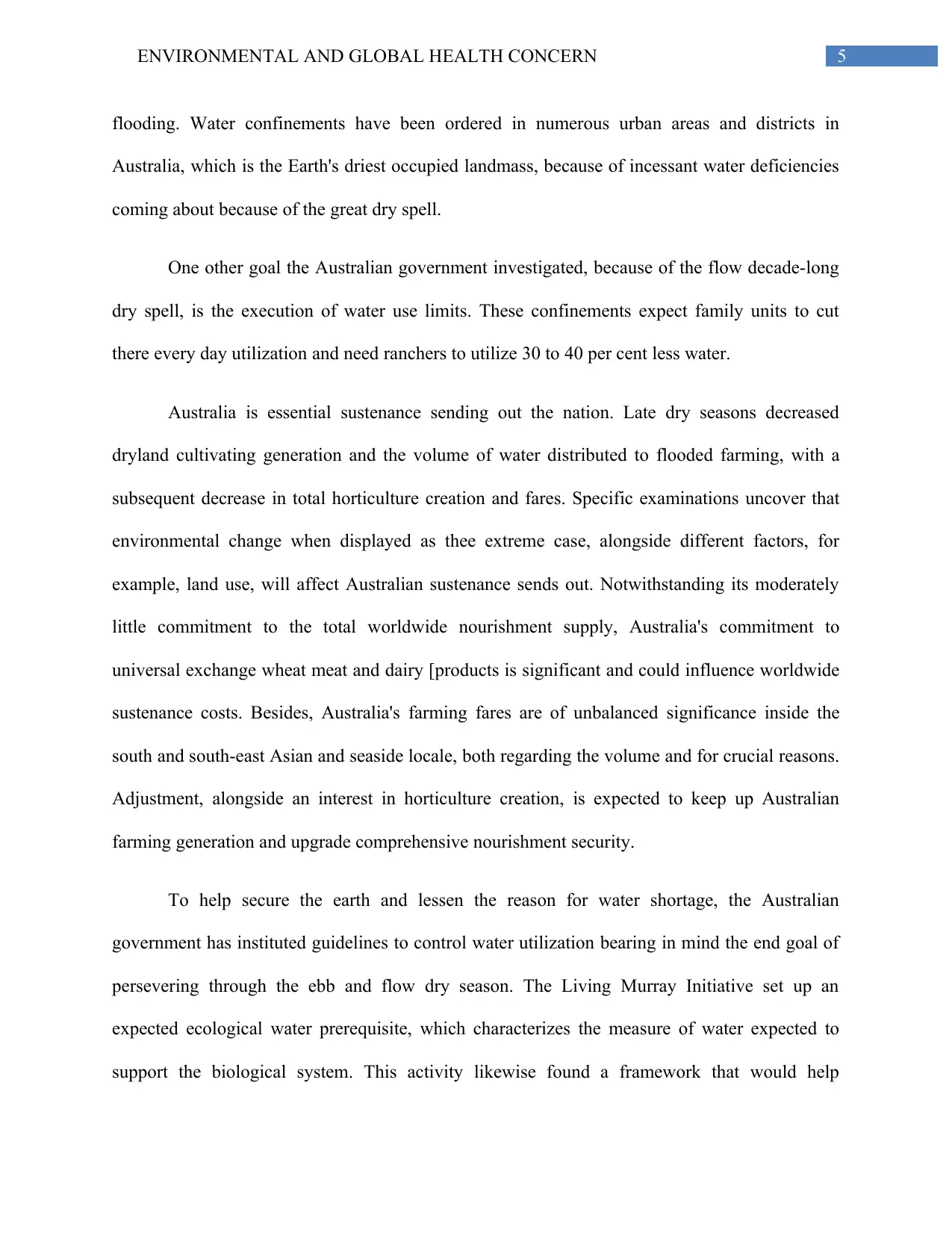
5ENVIRONMENTAL AND GLOBAL HEALTH CONCERN
flooding. Water confinements have been ordered in numerous urban areas and districts in
Australia, which is the Earth's driest occupied landmass, because of incessant water deficiencies
coming about because of the great dry spell.
One other goal the Australian government investigated, because of the flow decade-long
dry spell, is the execution of water use limits. These confinements expect family units to cut
there every day utilization and need ranchers to utilize 30 to 40 per cent less water.
Australia is essential sustenance sending out the nation. Late dry seasons decreased
dryland cultivating generation and the volume of water distributed to flooded farming, with a
subsequent decrease in total horticulture creation and fares. Specific examinations uncover that
environmental change when displayed as thee extreme case, alongside different factors, for
example, land use, will affect Australian sustenance sends out. Notwithstanding its moderately
little commitment to the total worldwide nourishment supply, Australia's commitment to
universal exchange wheat meat and dairy [products is significant and could influence worldwide
sustenance costs. Besides, Australia's farming fares are of unbalanced significance inside the
south and south-east Asian and seaside locale, both regarding the volume and for crucial reasons.
Adjustment, alongside an interest in horticulture creation, is expected to keep up Australian
farming generation and upgrade comprehensive nourishment security.
To help secure the earth and lessen the reason for water shortage, the Australian
government has instituted guidelines to control water utilization bearing in mind the end goal of
persevering through the ebb and flow dry season. The Living Murray Initiative set up an
expected ecological water prerequisite, which characterizes the measure of water expected to
support the biological system. This activity likewise found a framework that would help
flooding. Water confinements have been ordered in numerous urban areas and districts in
Australia, which is the Earth's driest occupied landmass, because of incessant water deficiencies
coming about because of the great dry spell.
One other goal the Australian government investigated, because of the flow decade-long
dry spell, is the execution of water use limits. These confinements expect family units to cut
there every day utilization and need ranchers to utilize 30 to 40 per cent less water.
Australia is essential sustenance sending out the nation. Late dry seasons decreased
dryland cultivating generation and the volume of water distributed to flooded farming, with a
subsequent decrease in total horticulture creation and fares. Specific examinations uncover that
environmental change when displayed as thee extreme case, alongside different factors, for
example, land use, will affect Australian sustenance sends out. Notwithstanding its moderately
little commitment to the total worldwide nourishment supply, Australia's commitment to
universal exchange wheat meat and dairy [products is significant and could influence worldwide
sustenance costs. Besides, Australia's farming fares are of unbalanced significance inside the
south and south-east Asian and seaside locale, both regarding the volume and for crucial reasons.
Adjustment, alongside an interest in horticulture creation, is expected to keep up Australian
farming generation and upgrade comprehensive nourishment security.
To help secure the earth and lessen the reason for water shortage, the Australian
government has instituted guidelines to control water utilization bearing in mind the end goal of
persevering through the ebb and flow dry season. The Living Murray Initiative set up an
expected ecological water prerequisite, which characterizes the measure of water expected to
support the biological system. This activity likewise found a framework that would help
⊘ This is a preview!⊘
Do you want full access?
Subscribe today to unlock all pages.

Trusted by 1+ million students worldwide
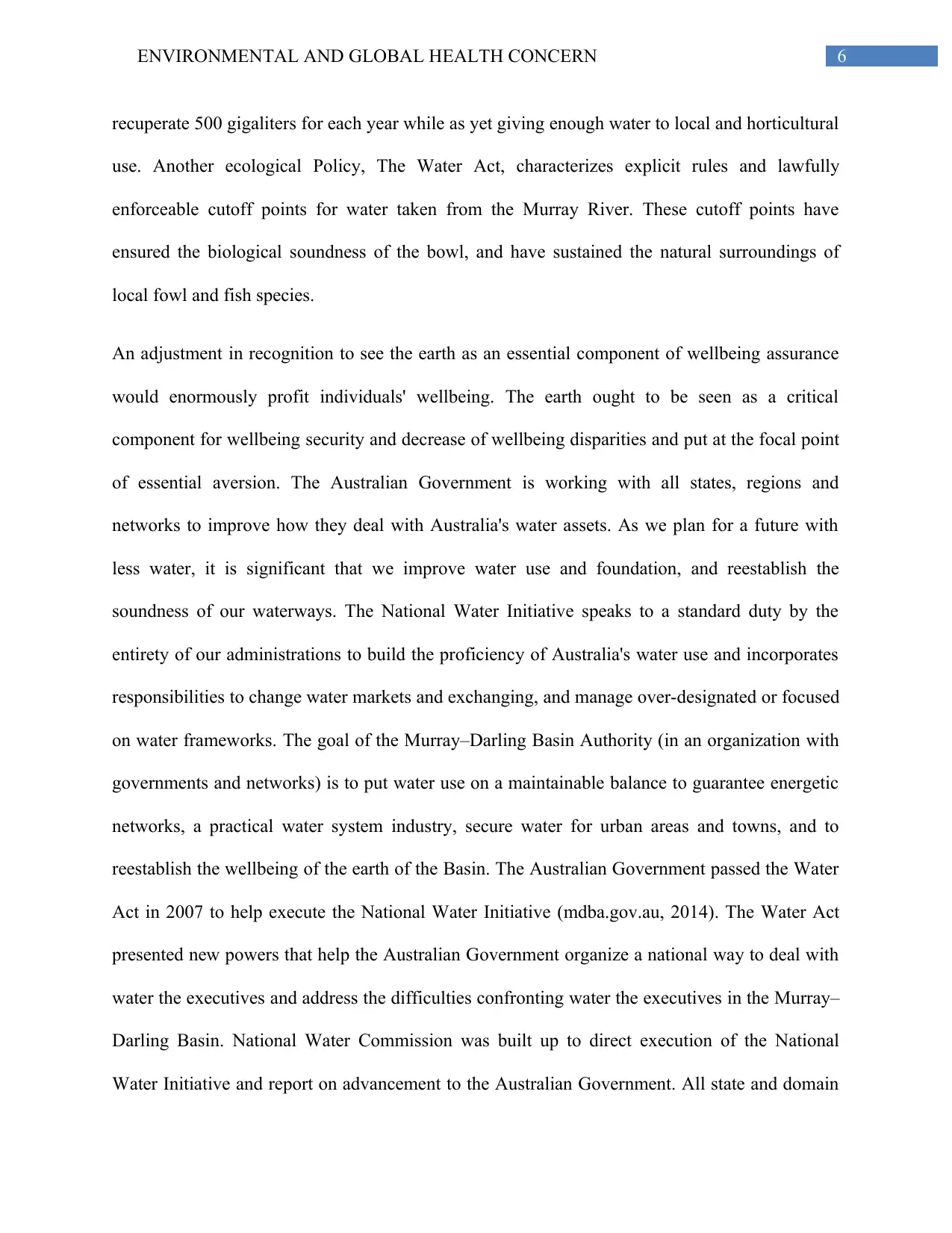
6ENVIRONMENTAL AND GLOBAL HEALTH CONCERN
recuperate 500 gigaliters for each year while as yet giving enough water to local and horticultural
use. Another ecological Policy, The Water Act, characterizes explicit rules and lawfully
enforceable cutoff points for water taken from the Murray River. These cutoff points have
ensured the biological soundness of the bowl, and have sustained the natural surroundings of
local fowl and fish species.
An adjustment in recognition to see the earth as an essential component of wellbeing assurance
would enormously profit individuals' wellbeing. The earth ought to be seen as a critical
component for wellbeing security and decrease of wellbeing disparities and put at the focal point
of essential aversion. The Australian Government is working with all states, regions and
networks to improve how they deal with Australia's water assets. As we plan for a future with
less water, it is significant that we improve water use and foundation, and reestablish the
soundness of our waterways. The National Water Initiative speaks to a standard duty by the
entirety of our administrations to build the proficiency of Australia's water use and incorporates
responsibilities to change water markets and exchanging, and manage over-designated or focused
on water frameworks. The goal of the Murray–Darling Basin Authority (in an organization with
governments and networks) is to put water use on a maintainable balance to guarantee energetic
networks, a practical water system industry, secure water for urban areas and towns, and to
reestablish the wellbeing of the earth of the Basin. The Australian Government passed the Water
Act in 2007 to help execute the National Water Initiative (mdba.gov.au, 2014). The Water Act
presented new powers that help the Australian Government organize a national way to deal with
water the executives and address the difficulties confronting water the executives in the Murray–
Darling Basin. National Water Commission was built up to direct execution of the National
Water Initiative and report on advancement to the Australian Government. All state and domain
recuperate 500 gigaliters for each year while as yet giving enough water to local and horticultural
use. Another ecological Policy, The Water Act, characterizes explicit rules and lawfully
enforceable cutoff points for water taken from the Murray River. These cutoff points have
ensured the biological soundness of the bowl, and have sustained the natural surroundings of
local fowl and fish species.
An adjustment in recognition to see the earth as an essential component of wellbeing assurance
would enormously profit individuals' wellbeing. The earth ought to be seen as a critical
component for wellbeing security and decrease of wellbeing disparities and put at the focal point
of essential aversion. The Australian Government is working with all states, regions and
networks to improve how they deal with Australia's water assets. As we plan for a future with
less water, it is significant that we improve water use and foundation, and reestablish the
soundness of our waterways. The National Water Initiative speaks to a standard duty by the
entirety of our administrations to build the proficiency of Australia's water use and incorporates
responsibilities to change water markets and exchanging, and manage over-designated or focused
on water frameworks. The goal of the Murray–Darling Basin Authority (in an organization with
governments and networks) is to put water use on a maintainable balance to guarantee energetic
networks, a practical water system industry, secure water for urban areas and towns, and to
reestablish the wellbeing of the earth of the Basin. The Australian Government passed the Water
Act in 2007 to help execute the National Water Initiative (mdba.gov.au, 2014). The Water Act
presented new powers that help the Australian Government organize a national way to deal with
water the executives and address the difficulties confronting water the executives in the Murray–
Darling Basin. National Water Commission was built up to direct execution of the National
Water Initiative and report on advancement to the Australian Government. All state and domain
Paraphrase This Document
Need a fresh take? Get an instant paraphrase of this document with our AI Paraphraser
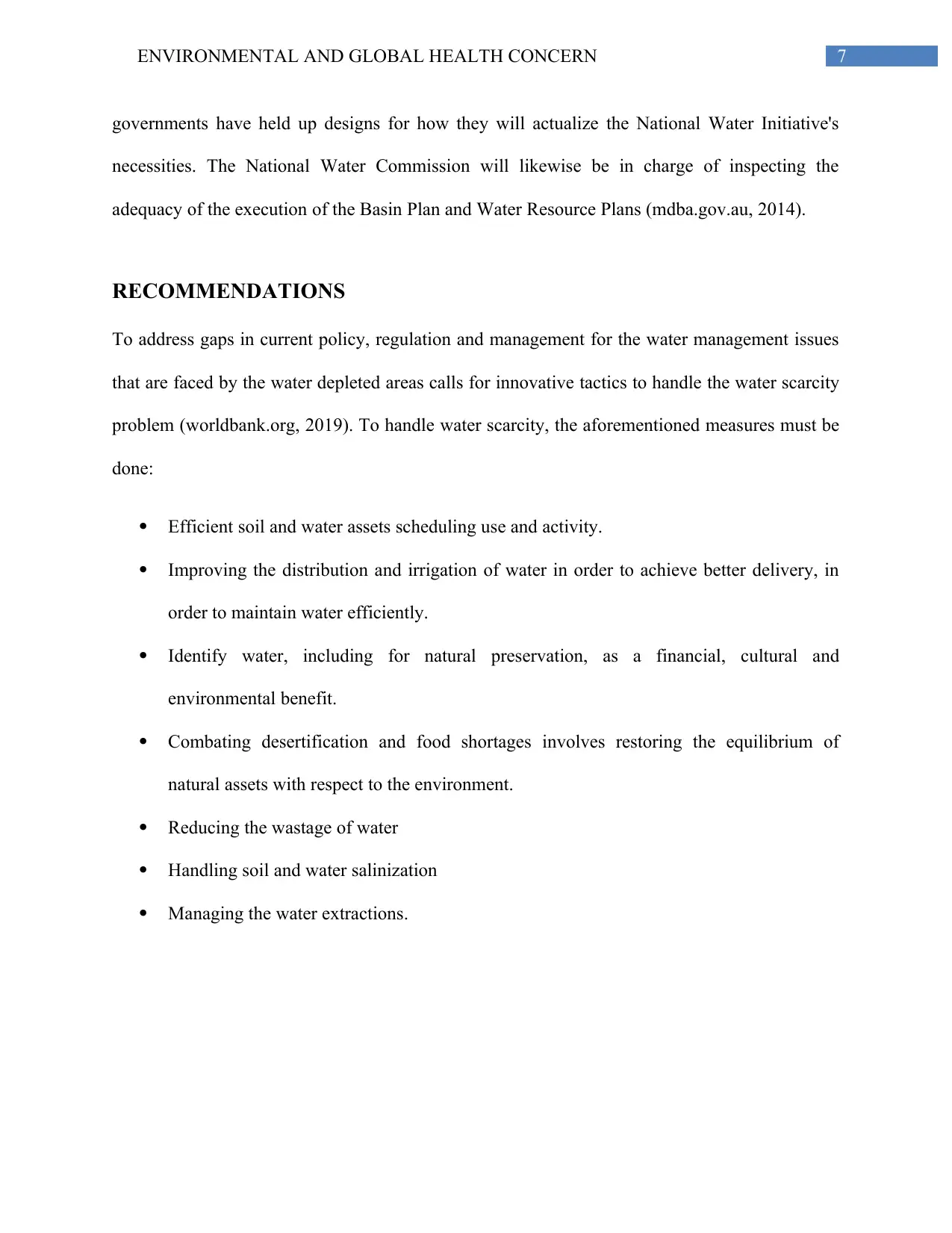
7ENVIRONMENTAL AND GLOBAL HEALTH CONCERN
governments have held up designs for how they will actualize the National Water Initiative's
necessities. The National Water Commission will likewise be in charge of inspecting the
adequacy of the execution of the Basin Plan and Water Resource Plans (mdba.gov.au, 2014).
RECOMMENDATIONS
To address gaps in current policy, regulation and management for the water management issues
that are faced by the water depleted areas calls for innovative tactics to handle the water scarcity
problem (worldbank.org, 2019). To handle water scarcity, the aforementioned measures must be
done:
Efficient soil and water assets scheduling use and activity.
Improving the distribution and irrigation of water in order to achieve better delivery, in
order to maintain water efficiently.
Identify water, including for natural preservation, as a financial, cultural and
environmental benefit.
Combating desertification and food shortages involves restoring the equilibrium of
natural assets with respect to the environment.
Reducing the wastage of water
Handling soil and water salinization
Managing the water extractions.
governments have held up designs for how they will actualize the National Water Initiative's
necessities. The National Water Commission will likewise be in charge of inspecting the
adequacy of the execution of the Basin Plan and Water Resource Plans (mdba.gov.au, 2014).
RECOMMENDATIONS
To address gaps in current policy, regulation and management for the water management issues
that are faced by the water depleted areas calls for innovative tactics to handle the water scarcity
problem (worldbank.org, 2019). To handle water scarcity, the aforementioned measures must be
done:
Efficient soil and water assets scheduling use and activity.
Improving the distribution and irrigation of water in order to achieve better delivery, in
order to maintain water efficiently.
Identify water, including for natural preservation, as a financial, cultural and
environmental benefit.
Combating desertification and food shortages involves restoring the equilibrium of
natural assets with respect to the environment.
Reducing the wastage of water
Handling soil and water salinization
Managing the water extractions.
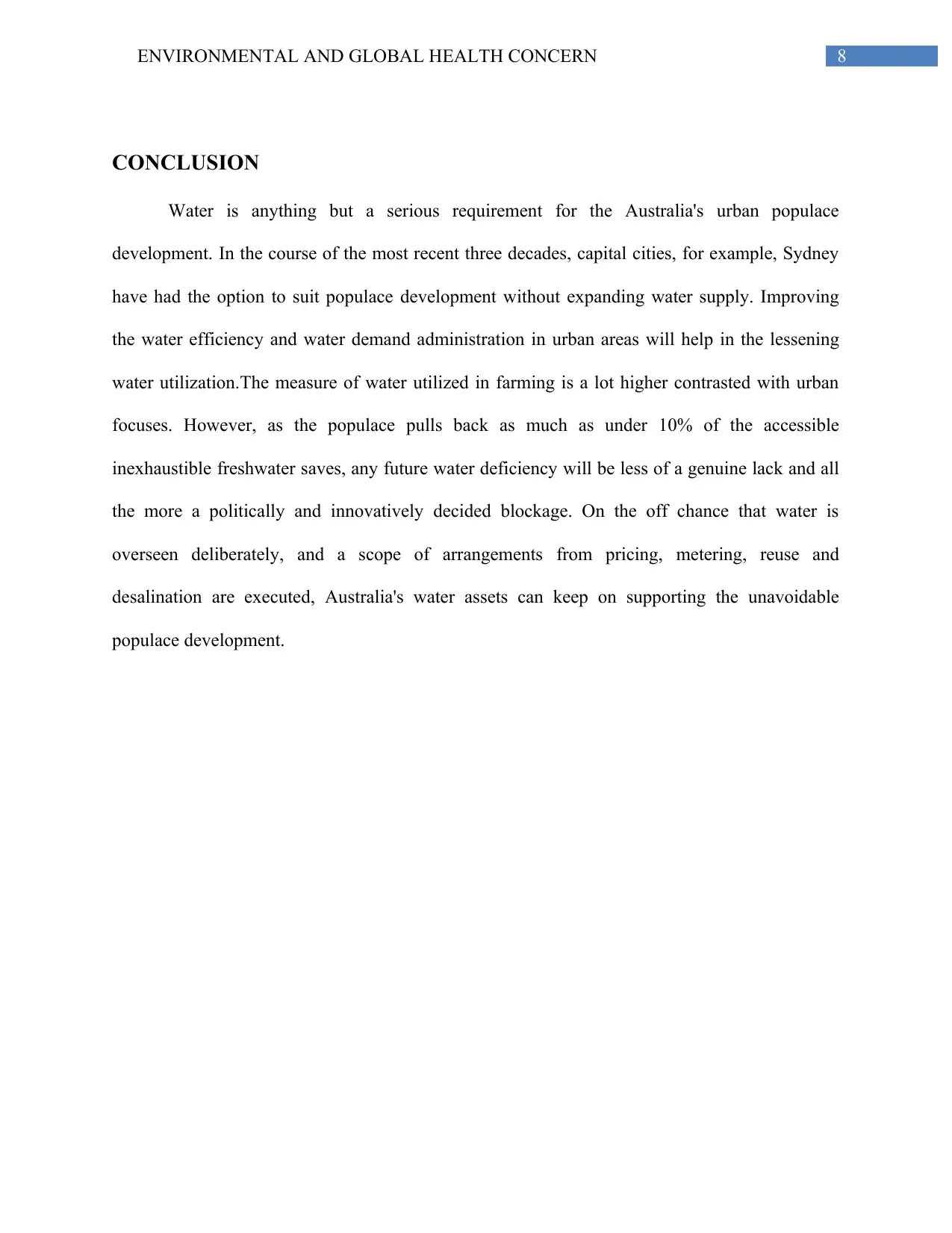
8ENVIRONMENTAL AND GLOBAL HEALTH CONCERN
CONCLUSION
Water is anything but a serious requirement for the Australia's urban populace
development. In the course of the most recent three decades, capital cities, for example, Sydney
have had the option to suit populace development without expanding water supply. Improving
the water efficiency and water demand administration in urban areas will help in the lessening
water utilization.The measure of water utilized in farming is a lot higher contrasted with urban
focuses. However, as the populace pulls back as much as under 10% of the accessible
inexhaustible freshwater saves, any future water deficiency will be less of a genuine lack and all
the more a politically and innovatively decided blockage. On the off chance that water is
overseen deliberately, and a scope of arrangements from pricing, metering, reuse and
desalination are executed, Australia's water assets can keep on supporting the unavoidable
populace development.
CONCLUSION
Water is anything but a serious requirement for the Australia's urban populace
development. In the course of the most recent three decades, capital cities, for example, Sydney
have had the option to suit populace development without expanding water supply. Improving
the water efficiency and water demand administration in urban areas will help in the lessening
water utilization.The measure of water utilized in farming is a lot higher contrasted with urban
focuses. However, as the populace pulls back as much as under 10% of the accessible
inexhaustible freshwater saves, any future water deficiency will be less of a genuine lack and all
the more a politically and innovatively decided blockage. On the off chance that water is
overseen deliberately, and a scope of arrangements from pricing, metering, reuse and
desalination are executed, Australia's water assets can keep on supporting the unavoidable
populace development.
⊘ This is a preview!⊘
Do you want full access?
Subscribe today to unlock all pages.

Trusted by 1+ million students worldwide
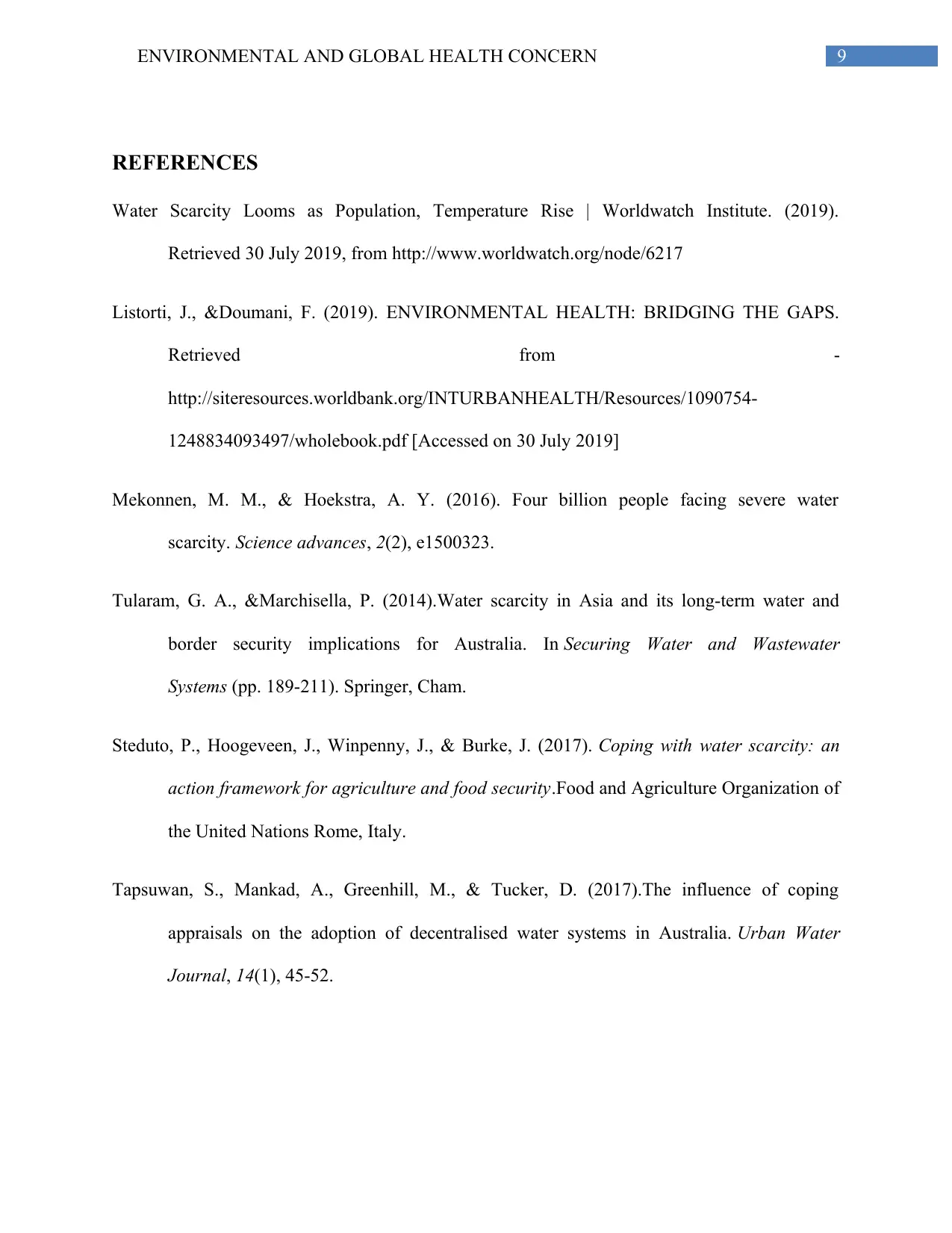
9ENVIRONMENTAL AND GLOBAL HEALTH CONCERN
REFERENCES
Water Scarcity Looms as Population, Temperature Rise | Worldwatch Institute. (2019).
Retrieved 30 July 2019, from http://www.worldwatch.org/node/6217
Listorti, J., &Doumani, F. (2019). ENVIRONMENTAL HEALTH: BRIDGING THE GAPS.
Retrieved from -
http://siteresources.worldbank.org/INTURBANHEALTH/Resources/1090754-
1248834093497/wholebook.pdf [Accessed on 30 July 2019]
Mekonnen, M. M., & Hoekstra, A. Y. (2016). Four billion people facing severe water
scarcity. Science advances, 2(2), e1500323.
Tularam, G. A., &Marchisella, P. (2014).Water scarcity in Asia and its long-term water and
border security implications for Australia. In Securing Water and Wastewater
Systems (pp. 189-211). Springer, Cham.
Steduto, P., Hoogeveen, J., Winpenny, J., & Burke, J. (2017). Coping with water scarcity: an
action framework for agriculture and food security.Food and Agriculture Organization of
the United Nations Rome, Italy.
Tapsuwan, S., Mankad, A., Greenhill, M., & Tucker, D. (2017).The influence of coping
appraisals on the adoption of decentralised water systems in Australia. Urban Water
Journal, 14(1), 45-52.
REFERENCES
Water Scarcity Looms as Population, Temperature Rise | Worldwatch Institute. (2019).
Retrieved 30 July 2019, from http://www.worldwatch.org/node/6217
Listorti, J., &Doumani, F. (2019). ENVIRONMENTAL HEALTH: BRIDGING THE GAPS.
Retrieved from -
http://siteresources.worldbank.org/INTURBANHEALTH/Resources/1090754-
1248834093497/wholebook.pdf [Accessed on 30 July 2019]
Mekonnen, M. M., & Hoekstra, A. Y. (2016). Four billion people facing severe water
scarcity. Science advances, 2(2), e1500323.
Tularam, G. A., &Marchisella, P. (2014).Water scarcity in Asia and its long-term water and
border security implications for Australia. In Securing Water and Wastewater
Systems (pp. 189-211). Springer, Cham.
Steduto, P., Hoogeveen, J., Winpenny, J., & Burke, J. (2017). Coping with water scarcity: an
action framework for agriculture and food security.Food and Agriculture Organization of
the United Nations Rome, Italy.
Tapsuwan, S., Mankad, A., Greenhill, M., & Tucker, D. (2017).The influence of coping
appraisals on the adoption of decentralised water systems in Australia. Urban Water
Journal, 14(1), 45-52.
Paraphrase This Document
Need a fresh take? Get an instant paraphrase of this document with our AI Paraphraser
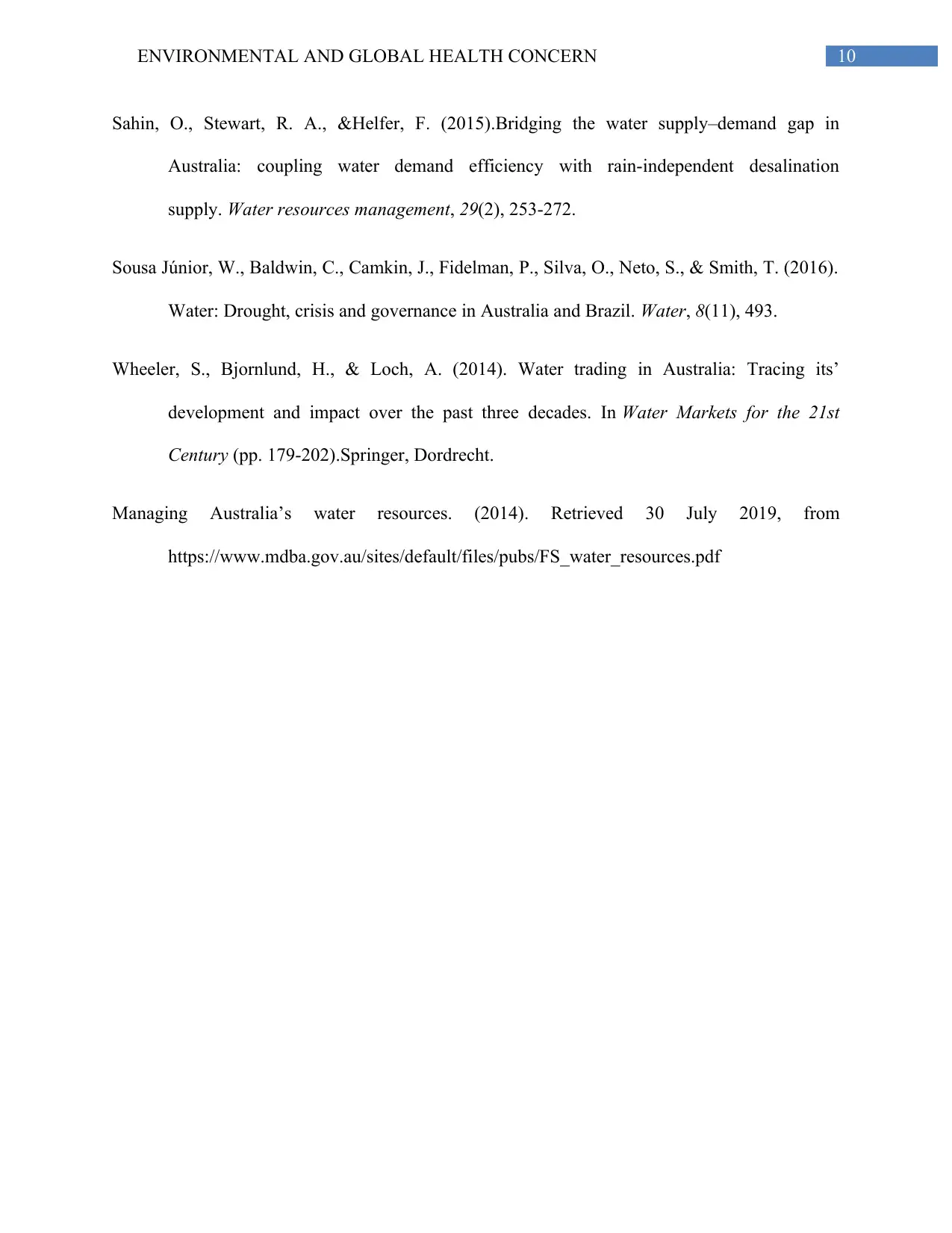
10ENVIRONMENTAL AND GLOBAL HEALTH CONCERN
Sahin, O., Stewart, R. A., &Helfer, F. (2015).Bridging the water supply–demand gap in
Australia: coupling water demand efficiency with rain-independent desalination
supply. Water resources management, 29(2), 253-272.
Sousa Júnior, W., Baldwin, C., Camkin, J., Fidelman, P., Silva, O., Neto, S., & Smith, T. (2016).
Water: Drought, crisis and governance in Australia and Brazil. Water, 8(11), 493.
Wheeler, S., Bjornlund, H., & Loch, A. (2014). Water trading in Australia: Tracing its’
development and impact over the past three decades. In Water Markets for the 21st
Century (pp. 179-202).Springer, Dordrecht.
Managing Australia’s water resources. (2014). Retrieved 30 July 2019, from
https://www.mdba.gov.au/sites/default/files/pubs/FS_water_resources.pdf
Sahin, O., Stewart, R. A., &Helfer, F. (2015).Bridging the water supply–demand gap in
Australia: coupling water demand efficiency with rain-independent desalination
supply. Water resources management, 29(2), 253-272.
Sousa Júnior, W., Baldwin, C., Camkin, J., Fidelman, P., Silva, O., Neto, S., & Smith, T. (2016).
Water: Drought, crisis and governance in Australia and Brazil. Water, 8(11), 493.
Wheeler, S., Bjornlund, H., & Loch, A. (2014). Water trading in Australia: Tracing its’
development and impact over the past three decades. In Water Markets for the 21st
Century (pp. 179-202).Springer, Dordrecht.
Managing Australia’s water resources. (2014). Retrieved 30 July 2019, from
https://www.mdba.gov.au/sites/default/files/pubs/FS_water_resources.pdf
1 out of 11
Related Documents
Your All-in-One AI-Powered Toolkit for Academic Success.
+13062052269
info@desklib.com
Available 24*7 on WhatsApp / Email
![[object Object]](/_next/static/media/star-bottom.7253800d.svg)
Unlock your academic potential
Copyright © 2020–2025 A2Z Services. All Rights Reserved. Developed and managed by ZUCOL.





